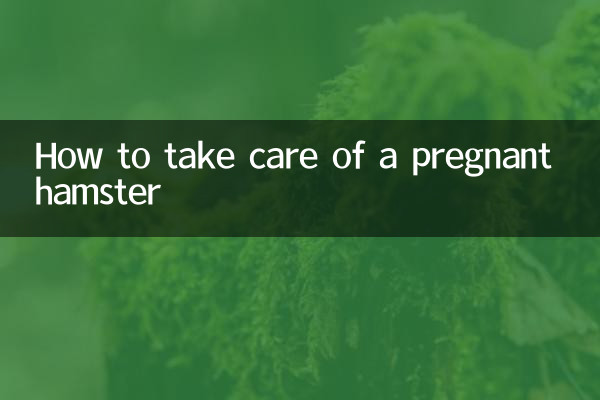How to take care of a pregnant hamster
Recently, the topic of pet raising has continued to increase in popularity on social media, especially regarding the pregnancy care of small pets such as hamsters. Many novice hamster owners have questions about signs of pregnancy, dietary adjustments, and environmental management. This article combines popular discussions on the Internet in the past 10 days to compile a structured guide to help owners scientifically care for pregnant hamsters.
1. Common signs of pregnancy in hamsters

Pregnant hamsters will show the following typical behavioral or physiological changes, which require close observation by owners:
| sign | Specific performance |
|---|---|
| weight gain | The abdomen is obviously bulging, and the weight increases by 10-15 grams in a short period of time |
| Increased food intake | Eating frequently, especially high-protein foods |
| decreased activity | Movement becomes slower and often hides in the nest |
| Increased aggression | Sensitive to companion or human touch, may bite |
2. Diet management during pregnancy
Balanced nutrition is the key to ensuring the health of mother rats and pups:
| food type | Recommended ratio | Things to note |
|---|---|---|
| high protein food | 30%-40% | Boiled chicken breast, hard-boiled eggs, mealworms |
| fresh fruits and vegetables | 20% | Carrots, apples (core removed), avoid high-sugar fruits |
| staple food | 40%-50% | Choose specialized hamster food and avoid brands containing additives |
3. Key points of environmental layout
Provide a safe and comfortable environment for pregnant hamsters:
1.Raised alone: After pregnancy, the cages need to be separated immediately to avoid interference from male rats or attacks by similar animals.
2.Mat material selection: Use dust-free paper wool or sawdust, at least 5cm thick to make holes for nesting.
3.reduce interruptions: It is forbidden to clean the cage within 2 weeks after giving birth to prevent the mother rat from abandoning her pups due to stress.
4.temperature control: Keep at 20-25℃, use pet heating pad in winter (avoid direct contact).
4. Precautions for postpartum care
Key care measures for puppies after birth:
| time stage | Nursing focus |
|---|---|
| 0-7 days | It is forbidden to touch the pups. The mother rats will breastfeed on their own. |
| 7-14 days | It can supplement the nutrition of mother rats and observe the opening of eyes of pups. |
| 14-21 days | The cubs start to eat soft food and need to be pre-separated according to gender. |
5. Frequently Asked Questions
Based on recent frequent questions from netizens, the following answers have been compiled:
Q: How long is the gestation period for hamsters?
A: Usually 16-22 days, the difference between breeds is small (such as dwarf hamster about 18 days, Syrian hamster about 20 days).
Q: Do I need extra calcium supplement?
A: It can be supplemented with a small amount of cheese or pet calcium tablets. Excessive dosage will cause constipation.
Q: What should I do if I have difficult labor?
A: If the mother rat does not give birth for more than 24 hours or the mother rat is weak, you need to contact an exotic pet veterinarian immediately.
Through scientific diet management, environmental optimization and postpartum care, the health of pregnant hamsters can be effectively improved. If you find abnormal behavior, it is recommended to consult a professional pet doctor in time.

check the details

check the details